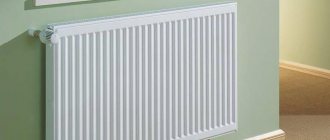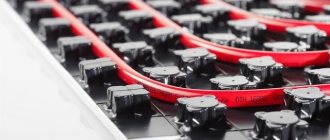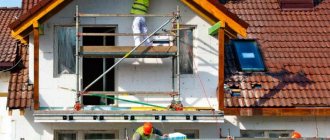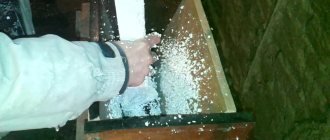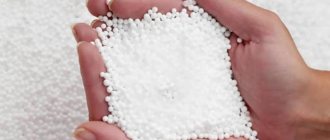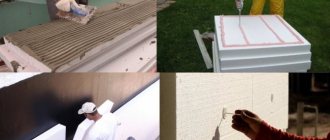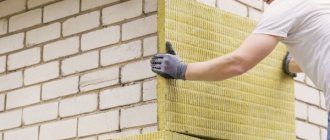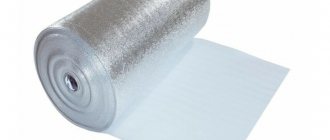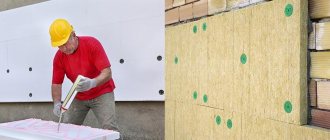Expanded polystyrene is a modern insulation material created using heat treatment with the addition of polymer granules to a foaming component in an extruder. “Extrusion” is a technological process in which a component is pressed into a foam mass at high temperature to give it the desired properties.
As a result of this process, the new material compares favorably with conventional foam in a number of parameters:
- high strength, water resistance, low vapor permeability, durability, environmental friendliness, fire safety.
High thermal insulation qualities and durability have made expanded polystyrene almost indispensable for insulating buildings. More than 75% of the territory of our country is in harsh climatic conditions.
There are several ways to use polystyrene.
Laying foam plastic inside hollow walls. This method is applicable directly during construction. The method of insulating walls with polystyrene from the outside has become widely used. This is the most commonly used method, which is used both in the construction and reconstruction of various objects, and insulation of already constructed buildings.
The use of expanded polystyrene in the construction and reconstruction of buildings
External wall insulation with polystyrene foam has received the most widespread use in the use of this material. The thickness of the sheets in this case is from 50 mm to 100 mm.
Before starting this work, wall preparation is important. The foam is attached to the walls using special glue and plastic mushroom-shaped dowels. According to the work technology, reinforcement with dowels is carried out only three days after gluing.
For corners use a special corner profile.
All this prevents the material from slipping while the glue dries during work. After all, the amount of slipping of even a light sheet can reach 10 cm. After gluing the foam sheets, a reinforcing mesh is used to create a more rigid layer under the plaster. This will make it easier in the future to finish the building’s exterior, plastering and painting. External thermal insulation work can only be carried out on days without rain.
Application of mastic under the mesh, leveling mastic, or primer should be done only after the previous layer has dried. The air temperature must be at least 5 C°. High environmental characteristics and fire safety made it possible to use this material for insulation from the inside of the house. Such work is carried out if external installation is impossible or inconvenient.
How is polystyrene foam extruded?
Extruded polystyrene foam is the most common type of gas-filled polymer. It is extruded using technology that was developed more than 50 years ago and continues to be successfully used today.
The material is extruded in the following way:
- polystyrene granules are mixed with a foaming agent at high temperature;
- Then, using an extruder, the resulting mass is squeezed out.
Previously, the material was extruded using hard freons, then they began to use a mixture of soft and hard ones, and then switched to freon-free systems. They began to extrude polystyrene foam in this way at the end of the last century, when most European countries banned freon-containing materials for insulation.
Features of the work on insulation with polystyrene foam from inside the house
Insulating walls with foam plastic from the inside of a house has its advantages and disadvantages. The work on fastening to the wall is not affected by external weather factors; the area of the insulated surface is relatively small, which eliminates unwanted sliding of the sheets. As a disadvantage, one can note the reduction in the internal volume of the building.
The additional thickness of the insulating structure further reduces the area of the rooms. For internal installation of insulation, the thickness of the foam sheets can be no more than 40 mm, and fastening can only be done with glue. The use of profiles for laying foam plastic and additional fastening with dowels can be abandoned.
It is quite possible to do this work yourself. How to attach polystyrene foam to the wall. There are two ways to attach foam to the wall - using glue and mechanical fastening with dowels “fungi”. Mechanical fastening is usually used as additional fixation of glued foam. To fasten using this method, it is necessary to profile the wall with thin wooden blocks or special profiles.
They are aligned in a plane; this determines how evenly the polystyrene sheets can be strengthened. Holes are drilled in the profile according to the diameter of the dowels used, usually 8 mm. Using dowels and these holes, the material is attached to the bars. We will not consider fastening with drilling directly into the wall as extremely inconvenient.
Self-installation of polystyrene foam
As can be seen from the two descriptions, insulating walls using polystyrene foam yourself, both on a regular concrete and brick surface and on wooden beams, does not present many difficulties. The main condition for good masonry is step-by-step execution, high-quality materials used, strict adherence to recommendations and instructions, as well as desire and patience in the work. Any installation of such material will reliably protect the house from adverse conditions, protect the wood from rotting and deterioration, and also ensure good ventilation of the room and insulation.
This material is safe, non-toxic and will last for many years without repair or restoration. It has good thermal insulation, steam does not condense on it, and fungi and mold do not multiply. As an addition, you can treat the walls with a solution and disinfect the area before laying. This will help get rid of existing fungus and microorganisms on the surface of the wall. But this is done if necessary. There is no need to spend money and effort for prevention if the surface is normal.
The optimal way to attach insulation to the wall from inside the house
The most convenient and less expensive method of fastening is fastening with glue. The possibility of abandoning the mechanical method was discussed above - small areas and the absence of unfavorable climatic factors.
This work can be carried out in several steps over two days:
Preparing the wall surface. The quality of the entire work depends on the basis on which the insulating material rests. The quality of surface preparation determines how firmly the foam will stick to the wall and how much glue will be needed to attach the sheets.
The wall must be carefully leveled and primed. The surface of the foam, on the contrary, should be rough for better adhesion to the glue. Selection of the optimal glue for attaching sheets of foam to the wall. Dry glue mixture or polyurethane foam glue?
It all depends on the skills at work. It takes much more time to properly prepare glue from a dry mixture, and the quality and consistency of the glue must be constantly monitored. Laying insulation sheets using polyurethane foam is faster and the adhesion is better.
But the complexity of preparing glue and the long duration of the work itself are compensated by the absence of errors with little experience in this field. Foam dries faster and requires experience and skill from the master. An important factor is that polyurethane glue in cylinders is much more expensive, and the quality of adhesion for glue made from a dry mixture is not much lower.
The glue is applied to the foam sheet using a notched trowel evenly over the entire surface in a layer of about 1 cm.
The sheets are glued to the wall starting from the bottom to avoid slipping while the glue dries. It is advisable to arrange the foam sheets in a checkerboard pattern, as when laying bricks. This way the whole structure will be more stable.
Gaps should be minimal. If foam is used, glue is applied around the perimeter of the sheet at a short distance from the edge and in the center. After gluing, the gaps between the sheets are filled with the same glue and puttied.
After the glue has dried, mastic is applied to the insulation and a reinforcing mesh is laid on it. The mesh should be recessed in a layer of mastic, this will give greater stability to the entire structure and will facilitate further work on the wall. The use of mastic and reinforcing mesh further strengthens the entire structure on the wall.
Plastering does not relate to the process of attaching polystyrene foam to the wall, but this is the logical completeness of the entire process. For all the work you will need: The polystyrene foam sheets themselves of the required area. A dry adhesive mixture at the rate of 3 kg per 1 m2 of wall area. 1 bag contains 25 kg of dry mixture. If you decide to use foam, 1 bottle replaces one bag of dry glue. Reinforcing mesh, mastic (consumption of the finished mixture is 2-3 kg per 1 m2). Spatula, trowel, level and a classic set of home craftsman tools (hammer, screwdriver, knife, ruler , compass, masking tape). An electric drill, if you are planning to fasten with dowels. The use of polystyrene foam for home insulation has its supporters and opponents.
Modern developments of this material make it possible to use it for residential premises without fear of adverse effects on health. Lightness, environmental friendliness and fire safety in addition to ease of installation make this material very competitive in construction and repair. Ivan Publitorov Insulating a house is an important issue for its owner. One of the most popular materials used for insulation and additional sound insulation is polystyrene foam. It is reliable and effective, does not put additional load on the walls. If the decision is made to use it, then the home owner is faced with the question of how to attach the foam to the wall, what kind of fastening to use in order to get a reliable, strong structure.
Foam plastic and penoplex are the most popular materials for insulation and sound insulation of house walls, because... they are practical and inexpensive.
How to fasten Penoplex boards inside?
There are difficulties with installing insulation from the outside, especially when the house is classified as an architectural monument. Fortunately, polystyrene foam boards can be mounted on the inside of the building. Effective extruded insulation can be installed in a thin layer, which saves additional space.
Insulation technology from the inside:
- Preparing the walls.
Cleaning of finishing materials, and preliminary leveling can be carried out.
- Applying glue
performed as usual: along the perimeter with small stripes inside. For reliable fastening, the manufacturer recommends proven adhesive for Penoplex Fastfix insulation. After 72 hours, doweling can be done with 4 disc dowels per sheet.
- Layout of sheets
also has a checkerboard pattern with ligation of seams due to indentations.
- Vapor barrier.
Expanded polystyrene is not afraid of moisture, and it does not matter which side the Penoplex is installed on. But with increased formation, steam can absorb a small part of it. To prevent this from happening, the insulation on the living room side is covered with a vapor barrier. The film with foil will additionally reflect heat, returning it inside the home. The joints of the vapor barrier are glued with special foil-coated tape.
- Frame for cladding
sheets are made of wooden beams, and the final decorative trim is mounted on top of it.
The easy-to-use material can be a little confusing for novice craftsmen. But even the pros don’t know for sure:
Is it possible to stick Penoplex boards onto tiles?
The walls of balconies and loggias in old houses are often tiled. Tearing down the old finish is not an easy process. Expanded polystyrene can be attached to a lined surface. It is enough to treat the base with a primer, for example concrete contact. And then, everything according to the technology described above.
Is it possible to glue wallpaper directly onto Penoplex?
It is better to hide smooth slabs of expanded polystyrene under the frame, covered with plasterboard sheets. The gypsum base will provide better adhesion for the decorative layer of wallpaper, tiles, paint, etc.
Preparatory work
Before attaching the foam, you need to prepare the surface.
There should be nothing on the wall that could interfere with the work. All structures must be removed. Clean the surface from dust.
If there are cracks, chips, unevenness or other damage on the wall, then they must be eliminated before attaching the insulation. Irregularities on the wall of more than 1 cm can cause insulation failure. If the walls are damp, they need to be dried.
The next important step in preparation is treating surfaces with special compounds that will prevent the formation of mold and mildew. The next stage of work can be started only after they have completely dried.
Scheme of insulating walls from the outside with polystyrene foam.
After the preparation is completed, you can begin drawing up a diagram of the location of the foam sheets on the wall.
Such a scheme will help to minimize losses from cutting sheets. On the wall they should be arranged in a checkerboard pattern. If the foam needs to be cut, then it is better to use a mounting knife.
The foam can be attached in several ways: with glue or mechanical fasteners.
To fasten foam plastic to the wall, use special dowels, which are also called umbrellas or mushrooms. You can use any of these methods, but, as practice shows, it is most rational to simultaneously glue and nail the foam. During facade work, this technology is most justified, especially if heavy facing materials will be used later.
It is better to fasten the insulation only with glue during interior work; this will be quite enough. Dowels do not need to be used as fastenings for foam plastic, since heavy facing materials are not used during interior work
Return to contents
The easiest way to attach foam to the wall is to use glue. Work begins from the bottom with the installation of a starting bar.
The plank will become a reliable support for the bottom row and will not allow it to move. This method will allow you to do the job correctly and with better quality. If you do not use the limiting strip, then until the adhesive mixture dries, the foam can drop up to 10 cm.
Scheme of external insulation from foam blocks.
The thickness of the starting strip should be equal to the thickness of the insulation sheet. In addition to the strip, to attach the insulation, you will need:
- Tile adhesive. Construction mixer. Electric drill. Large and small spatulas. Container for glue.
When preparing the adhesive mixture, you must strictly adhere to the instructions. Using a construction mixer attached to an electric drill, prepare the solution, strictly observing the proportions of water and dry mixture.
Return to contents
Two spatulas are needed to make it more convenient to work. The small one is used as a spatula to spread the mixture onto the large one.
On a perfectly flat wall, you can work with a spatula-comb with special teeth. If the surface has differences of more than 1 cm, then the mixture is applied to it with a spatula in separate “islands”. Due to this, all differences are leveled out as much as possible, that is, a larger amount of glue is placed on the unevenness, and less on the protrusions.
Graph of thermal insulation properties of insulation materials.
The adhesive mixture can also be placed on foam plastic. Manufacturers recommend applying it evenly over the entire surface.
But here you may encounter the following problem: if the wall is uneven, then half of the sheet may not stick. In addition, the sheet will become 3-5 kg heavier and will be inconvenient to work with: hold, fasten, level. Therefore, for convenience and reliability, it is better to apply glue to the wall.
The adhesive mixture is applied in “islands” along the perimeter of the foam sheet. "Islands" can be of various sizes. The main task is to level the insulated surface as much as possible if there are depressions on it.
All existing protrusions should be knocked down, if possible. Alternatively, you can scrape off the insulation sheet a little in the place where the protrusion hits. In addition, the glue must be applied to the wall along the perimeter of the sheet in a broken thick line.
For this it is better to use a small spatula. This technique will allow some of the glue to get under the adjacent sheets. Thanks to this, the joints will be more durable.
Attach the sheet to the prepared surface and press lightly. To avoid making dents, fasten carefully. The sheets are stacked in a checkerboard pattern.
Return to contents
One of the types of fastenings for foam plastic are special dowels - mushrooms, which consist of a plastic circle (hat and plastic sleeve) and a “leg”. A plastic or metal nail is driven into the sleeve. It is better to fasten with plastic nails.
For work, in addition to the dowels themselves, you will need:
- Perforator.Drill.Hammer.
The depth of the hole for fastening should be 20 mm greater than the length of the fungus. To decide how long to prepare the fungi, you need to add 1 cm to the thickness of the insulation as the thickness of the other layers on the wall and add another 3-4 cm to the recess.
For example, with a foam thickness of 50 mm, you will need mushrooms with a length of 50 + 10 + 40 = 100 mm. In this case, the depth of the hole will be 100+20=120 mm. You need to prepare a drill for the hammer drill of the same length.
Fasten the sheet with at least 5-6 dowels, placing one in the center, the rest at the joints of the sheets.
Thanks to this, the joints are better pressed. If necessary, you can attach more material. Dowels are considered the best and most reliable among foam fasteners.
First prepare the holes for the fasteners. Then insert the fungi into them, without nails for now.
Hammer it with a hammer so that the cap is level with the surface of the insulation. When all the fungi are installed, you can start driving nails inside. A correctly hammered mushroom is immersed in the insulation by 1-2 mm.
It is very important to take into account that the insulation can be nailed no earlier than 3 days after gluing is completed. During this time, the adhesive mixture will dry and the foam will not move away from the wall.
To insulate buildings during modern renovations, materials derived from polystyrene foam are often used: polystyrene foam, penoplex. Their composition is more than 90% air. This determines their high thermal insulation properties.
Before attaching polystyrene foam to the wall outside or inside the premises, you should prepare the working surfaces and decide on the installation method. Not only the service life of this material, but also the durability of the decorative finish will depend on the quality of fastening of the sheets.
Preparing the walls for installation
- For high-quality work, it is necessary to treat the wall from all kinds of irregularities, but if there are protruding elements, then you will need to make cutouts for them and paste them around the perimeter.
- The next step will be to work on processing all the depressions and scratches. They must be sealed and aligned with the wall as much as possible. There is no need to achieve perfect smoothness of the wall. It is enough for the material to lie flat against it. This can be checked by applying a vertical level. It is better to clean the wall surface from old paint, putty and other finishing materials, as they can prevent good sizing of the insulation, which will lead to its poor fastening or detachment from the wall.
- Then, when all these manipulations are done, you need to look at the evenness of the resulting wall using a level. If there are differences of 4-5 cm, then they can be easily adjusted with the future solution. Excessively large differences are very undesirable.
- The next step is to tear out and measure the bottom layer of the wall. The laying of insulation begins strictly from the bottom to the top in a horizontal position.
Preparatory activities
You can insulate a house with polystyrene foam in 2 ways: with glue or with special dowels
Insulation allows you to save on heating the room. You can attach the foam to the wall after preliminary preparation of the surface.
The process consists of performing a series of actions to level and strengthen the base. It all boils down to this:
- unnecessary structural elements are dismantled from the working surface; falling sections of the finishing coating are removed to a solid base, after which they are plastered again; the walls are checked for unevenness with a level; if necessary, the entire surface is leveled and puttied; after drying, the dust formed on the installation surface should be washed off with water (you can wipe with a damp cloth); when the moisture has evaporated, apply sequentially: a primer layer, a solution against mold and fungi (with a brush or spray); before attaching polystyrene foam, you should take measurements of the wall (to order consumables in the required quantity, in a convenient format).
Preparatory operations also include the selection of tools. To carry out the work, depending on the chosen fastening method, you will need the following set:
- spatulas of different sizes; construction knife, stapler; level, tape measure, pencil; hammer drill (impact drill); mixer or attachment for stirring the adhesive solution; sandpaper (grater); hammer; containers for glue, primer, plaster mixtures.
It is customary to pay great attention to preliminary preparation. Leveled walls without defects speed up further installation work, avoiding possible troubles (for example, panels falling off along with the plaster). It is recommended to use foam plastic 3 cm thick inside the rooms, and at least 5 cm thick outside.
Characteristics of extruded polystyrene foam
Extruded polystyrene has excellent qualities:
- High strength (withstands loads up to 35 t/m2),
- Resistance to aggressive environmental factors
- Waterproof,
- Durability – (operation up to 50 years),
- Low vapor permeability, zero capillarity
- Environmental friendliness (storage containers, disposable tableware and even toys are made from polystyrene foam),
- Does not support combustion without a flame source and high temperature
Extruded polystyrene foam is produced in different densities. New on the market - high-hardness EPPS - carbon polystyrene foam. It contains graphite particles in its structure, which gives it the ability to withstand loads of up to 50 t/m2. You can buy extruded polystyrene foam of this type in Kyiv from TM Technonikol, Penoplex and other manufacturers.
Polystyrene foam board
Density: 35 kg/m3 Sheet thickness: 20/30/40/50mm Sheet size: 1.25 m * 0.6 m Purpose: insulation of floors, walls, foundations
Mounting methods
Fastening with fungi Installation on plaster mixture is not the most reliable
Polystyrene foam is installed on the prepared base in many ways. A description of the most common of them is given in the table. The classification criterion lies in the materials used for fastening.
No. Method Procedure, features 1 use of plaster mixtures; a solution of the required consistency is prepared according to the instructions on the packaging; in this case, the volume should be mixed for approximately 3 hours of work (after which the mixture begins to lose its properties); the solution is applied with a spatula along the perimeter of the sheet in a continuous layer (thickness from 10 to 30 mm), then several contact points are established on the remaining surface (on average 5-6 are enough); the fragment is applied to the wall; gluing is carried out from the bottom up (it is advisable to do the work in a checkerboard pattern); the sheets are pressed tightly against each other to minimize the size of the gaps; if the distance between the joints exceeds 2 mm, then the area is sealed with polyurethane foam; the disadvantage is weak fixation, it is advisable to use mixtures together with the following two methods: 2 fastening with fungi, holes are drilled in the wall through polystyrene foam (with a diameter of 0.8 cm, depending on the thickness of the plastic part of the fungus); the dowel is inserted and hammered in so that it fits at least flush with the surface; the use of fungi allows both attaching and dismantling fragments without consequences; There are 2 common options for the location of dowel nails: 4 pieces in the corners, 1 in the center for one sheet; inserted along the joints, securing several fragments at once 3 with the help of adhesives; the scheme of work is similar to the use of plaster mixtures; It is easier to apply the glue with a gun. Attaching polystyrene foam or polystyrene foam to a brick wall, as well as a wooden, concrete, or stone wall can be done using any of the described methods.
Extruded polystyrene foam is gaining increasing popularity as insulation. In terms of its characteristics, it is superior to ordinary polystyrene foam, but is more expensive in price. To install it, you don’t need to invent anything - just use the methods outlined.
The use of the considered installation options allows you to securely fasten polystyrene foam for a long time (if all work is carried out correctly and sequentially). To achieve a high-quality result and some savings, the foundation should be insulated with polystyrene foam, and the rest of the facade with ordinary polystyrene foam. The best effect will be from the combined use of dowels with glue.
Technological data
This type of fastening of extruded polystyrene foam to the wall is intended mainly for masonry; a sheet 5 cm thick is taken, with a density of 25 kg/m3. Such parameters will be sufficient for effective protection from cold and frost, since its properties are similar to two brick layers.
Expanded polystyrene has excellent vapor permeability and this guarantees good ventilation inside the material, absence of condensation and moisture. It will not rot, become damp or deteriorate quickly.
Special cases at work
For gluing to a metal base, use liquid nails
Fastening polystyrene foam to a concrete, brick, or wooden wall are the most common cases. In practice, there are situations when it is necessary to fasten sheets of material to a metal surface. Then the work is done as follows:
- indoors and when high strength of the coating is not required, PVA glue is used: the intermediate material - burlap - is impregnated with it; after which it is fixed on the working surface; then slabs lubricated with the same adhesive are glued onto it; for exterior finishing it is better to use special polyurethane adhesives together with liquid nails (so that the attached slabs do not slide); you can attach the foam with polyurethane foam, applying it at 5 points on the sheet in a small amount.
The use of liquid nails separately does not provide this level of strength. Joint application will increase the speed of installation. To learn how to quickly glue polystyrene foam to walls, watch this video:
Insulation of balconies and loggias can be done without gluing sheets, spreading them out in the sheathing.
After installation, the entire surface is puttied according to the level. Sheathed either with plastic, or MDF, or gypsum board. From the outside, the foam is held, securely fixed, by the outer wall.
There are nuances when working. You can't provide for everyone. Knowledge of how to secure material and practical skills will allow you to cope with any obstacles.
To work in multi-storey buildings, professional high-altitude workers will be required
Insulating a house using polystyrene foam methods is easy to do yourself. They can be combined with each other.
The decision on how to attach depends on the operating conditions and financial capabilities. Only facade work may require the involvement of professional high-altitude workers. Well-attached sheets of foam plastic will allow you to insulate your home for decades while preserving the exterior finish.
09.10.2017
In order not to heat the air outside the house, owners try to install thermal insulation. For this, a wide variety of materials are used, ranging from mineral wool to polystyrene foam.
The most popular due to its technical characteristics and affordable price is polystyrene foam. To reduce the cost of work, the owners do all the work themselves. That’s why questions are often asked: how to attach polystyrene foam to the wall?
Technical description
Extruded foam is made from a foamed polymer mass with fire retardants and other additives. It is passed through an extruder to compact and form blanks. The release form depends on the purpose. These can be decorative items, pipe shells or slabs. The latter are in great demand for performing thermal insulation measures. The canvases have several versions with the following features:
- thin backing;
- corrugated surface for plastering;
- the edge is rectangular, with a mounting projection for overlap (quarter) or with grooves and ridges to form a monolithic web.
The result is a lightweight material with a low thermal conductivity coefficient: 25-45 kg/cub.m. and at a temperature of +25 degrees Celsius about 0.032 W/m*K. (0.026 at +10 degrees). For comparison: 4 cm of EPS is comparable to 14 cm of wood, 38 cm of concrete or 85 cm of brickwork. Samples with low specific gravity are used for insulation of walls and ceilings, heavier samples are used for foundations and plinths.
Other technical characteristics of extruded polystyrene foam are as follows:
| Parameter | Meaning | Description |
| Water absorption | 0,2 % | Moisture does not penetrate deeply only into the surface layer, since the structure of the material is represented by closed cells. The polymer as a whole can be used as additional waterproofing of the base. |
| Vapor permeability | 0.007-0.012 mg/m*h*Pa | This suggests that the fabric practically does not “breathe”, which explains the restrictions on use without ventilation systems. |
| Frost resistance | From 1000 cycles | Technical and physical parameters are maintained when the plates are cooled to -50 degrees Celsius. It is possible to reduce thermal conductivity by 5% after 1000 freeze-thaw cycles. |
| Working temperature | -50-+75 degrees Celsius | When the polymer fabric is heated above +80 degrees, the release of toxic substances begins. Therefore, for interior work in rooms with such differences, it is better to choose an alternative insulation. |
| Tensile strength | 2-3.6 kgf/sq.cm | The bending strength is 4-7.1 kgf/sq.cm. Both parameters depend on the density and thickness of the workpieces. That is, the values indicated are the maximum averaged ones. |
| Flammability | G3, G4 | The use of fire retardant components allows the class to be reduced to G1. The ability to burn cannot be completely excluded. But the material’s fire resistance is high enough so that it can be safely used in industrial, urban and private construction. |
| Sound absorption | 25 dB | XPS series EPS is used in facilities where impact-type noise insulation is needed. |
| Life time | From 45 years old | The service life declared by the manufacturer is valid only if the technological requirements for installation are met. |
Extruded polystyrene foam has standard dimensions: width - 600 mm (sometimes 580 mm), length - 1200 or 2400 mm (can be 1000 mm). Manufacturers also offer additional services for the implementation of projects according to agreed parameters with customers. The thickness of the products is in the range of 20-100 mm. The material is sold in packages of 4 pieces, which depends on the dimensions of the sheet. As a rule, the total height of the pack is approximately 40 cm.
See also: Catalog of companies that specialize in home insulation
Pros and cons of insulation
Considering the technical characteristics, we can conclude that the material is light and moisture resistant. At the same time, good strength is observed, which contributed to the emergence of a new thermal cladding such as sandwich panels.
Sandwich panel Source shumoizol.com
The advantages don't stop there. The slabs are also characterized by the following:
- inertness to fungi and mold (synthetic fabric is not a breeding ground for bacteria and parasites);
- resistance of polymer products to rotting and natural decomposition;
- versatility of use without the need for additional moisture protection of EPS insulation.
The chemical inertness of polystyrene foam is not absolute. The slabs are destroyed under the influence of building materials such as:
- oils – petroleum products;
- solvents – acetone, toluene;
- bitumen mastics and adhesives, paints and varnishes based on inorganic solvents.
It is worth noting that some advantages of EPS can also be disadvantages. These properties include vapor permeability, synthetic composition, cellular structure.
Enlarged EPPS Source sladkiyson.net
Let's take a closer look at each parameter:
- The material does not “breathe”. When insulating structures, the dew point shifts towards thermal insulation. That is, moisture will accumulate in polystyrene foam and turn into condensation, since steam does not pass through the slabs. This is a minus for both internal and external work with wooden buildings. Here it is necessary to provide natural or forced ventilation to solve the problem.
- By nature, the polymer composition cannot be classified as an absolutely environmentally friendly group of materials.
- High density is achieved through extrusion, but the insulation does not change the structure of foamed polystyrene. This explains the possibility of using the material as additional sound insulation. But EPS cannot absorb and reflect sound waves, it can only muffle (reduce the amplitude of vibrations).
In addition to the above, the disadvantages include sensitivity to ultraviolet rays. That is, the insulation is subject to mandatory protection from direct exposure to the sun. This can be cladding or facing material, plaster. Another disadvantage is that rodents easily chew through the slabs, which negatively affects the overall situation with heat loss.
Chewed polystyrene Source yandex.net
Mounting methods
In order for the insulation to fulfill its intended purpose, it must be properly secured to the base. Professional craftsmen use several methods to attach foam:
For the adhesive composition.
This option is suitable if the insulation will not be used as a basis for heavy finishing material. Using fasteners. A more reliable method, but also suitable for spruce on foam plastic, it is planned to install heavy decorative trim. A combination of the first and second options. The use of glue and dowels allows for the most reliable fixation.
But before you start installing polystyrene foam, you must prepare the base and all the necessary materials.
Where is polystyrene foam used?
The use of polystyrene foam for insulation.
Extruded polystyrene foam is suitable for insulating floors in rooms where the temperature is quite low. This material holds the maximum level of mechanical loads, and is also not afraid of moisture. It can be used if groundwater or aquifers are available. It is very important that it is possible to lay expanded polystyrene slabs directly on a concrete base; the main thing is to prevent the intersection of heat-insulating slabs with concrete joints.
Preparatory stage
First you need to buy all the necessary materials and tools that may be useful during the installation process:
Insulation.
The required quantity is calculated in advance and must be purchased with a reserve. During transportation and even during fastening, the slabs may be damaged, so a few sheets in stock will not harm. Starting profile. Adhesive composition suitable for external work. You also need to pay attention to whether it is suitable for fastening foam plastic. Fasteners (fungus dowel) if this method was chosen for fixation. Deep penetration primer. Roller or wide paint brush (for applying primer). Sealant. Perforator.
After all the equipment and materials have been purchased, you can begin preparing the foundation. To do this you need:
- Remove old decorative trim.
If there are areas that are crumbling, then they are eliminated. All facade elements that interfere with the installation of insulation are removed. All cracks and recesses whose depth exceeds 5 mm are sealed. For polystyrene foam, it is not important that the base be perfectly level.
But if there are large depressions, then mechanical stress may cause cracks to appear both on the insulation itself and on the decorative finish. And this reduces the effectiveness of thermal insulation. Clean stains and traces of fungus or mold. The last stage of preparing the base will be the use of deep penetration soil. Particular care is taken in areas of constant exposure to moisture (basement, foundation).
Only after the soil has dried can you begin installing the foam using the chosen method. Now let's take a closer look at each method.
Preparing walls before insulation with penoplex
Before fixing the insulation sheets, it is necessary to clean the surface from dust, oil and mastic contaminants, as well as poorly retained old mortar or a layer of paint. Only those coatings that cannot bear the load should be removed.
The old paint layer must be removed to a solid base mechanically or using special compounds. If fungus, mold or other negative microorganisms are present on the surface, then to eliminate them you should use appropriate mixtures with bactericidal properties.
Next, you need to thoroughly check the evenness of the walls, using a building level 2.5-3 m long. If recesses, holes, cracks or irregularities larger than 2 cm are found, then in order to avoid breaking the penoplex during the installation process, you should first plaster the surfaces with cement-sand mortar. After complete hardening, the walls need to be opened with a primer in 2 layers.
For adhesive composition
For reliable fixation, you need to choose an adhesive that is suitable for outdoor use.
Be sure to pay attention to the frost resistance of the composition, because it will be exposed to such effects more than once. And be sure to keep in mind that not all adhesive solutions are suitable for working with foam plastic. When purchasing, read the label; manufacturers indicate what materials the product is suitable for.
Important! You don’t need to feed pharmacies so that hemorrhoids go away once and for all, use a very effective cream...
Read more >>>
For those who are wondering how to properly attach polystyrene foam with glue, we will now look at step-by-step instructions.
Setting up a starting profile.
It is fixed around the perimeter of the entire building. It is on this that the entire insulation structure will rest, so its width corresponds to the thickness of the foam board. It is imperative to ensure that the profile is installed clearly horizontally.
To do this, use a building level. The profile is attached using dowels and nails. Preparation of the adhesive solution. Everything must be done strictly according to the instructions indicated on the package. Applying glue. The solution is applied to the entire surface of the insulation up to 1 cm thick.
In this case, you should not save, because the reliability of fixing the slab will depend on the amount of glue. Installation of the slab. The first sheet of foam plastic is laid in the starting profile from the corner of the building. You need to put a little pressure on it so that the element is securely fixed. The next sheet is laid, 5 mm away from the previous one. Fastening the next rows.
The top slabs should be staggered so that the seams do not overlap. And you also need to leave a small gap between the rows. After all the slabs are laid, the gaps are filled with sealant. You should not use polyurethane foam.
The final stage will be decorative finishing. This can only be done after the glue has completely dried.
Let's reveal the secret of which side to attach Penoplex?
Expanded polystyrene slabs have been purchased, they are packed together in packs of thick film and are waiting for work to begin. Even examining the sheets in detail, one cannot find an answer as to which side to lay extruded polystyrene foam and whether Penoplex has a front side.
Here are the answers to frequently asked questions about which side to attach Penoplex.
- Which side should I glue Penoplex on?
The structure of polystyrene foam boards is the same on both sides, therefore there is no strictly defined side for laying. The sequence itself
gluing is simple: apply glue and lean it against the mounting surface. The peculiarity of the slabs is that they are produced with a smooth surface. This threatens poor adhesion during self-installation. Advice from experienced craftsmen: if the slabs of extruded insulation are smooth, then before applying glue you should comb them with a grater, walk over them with a needle roller or scratch them with a stiff brush. The roughness obtained in this way will ensure reliable fixation. - Where is the front or back side of polystyrene foam?
This question never confuses professionals, since Penoplex has no front or back side. Therefore, when working with extrusion, no unnecessary questions arise in this regard. It is much more important to ensure that the L-edges match and the seams overlap in the case of a two-layer insulation system.
Important:
The use of extruded polystyrene foam without finishing is not recommended. Although the insulation is not afraid of moisture, like mineral wool, the enemy of extrusion is ultraviolet radiation. Under a coating of plaster and putty, Penoplex brand insulation retains its properties for at least 50 years.
- On what surfaces can Penoplex be placed?
Expanded polystyrene thermal insulation is universal and is perfect for most structures. The slabs are widely used for insulating brick buildings, walls made of foam and gas blocks, reinforced concrete foundations and slabs. In this case, there is absolutely no difference which side to place Penoplex 50 mm on the floor, to the wall or attach to the ceiling. It is convenient to sheathe vertical and horizontal bases with insulation. Sheets can hide small protrusions on the base and height differences.
Insulation with Penoplex slabs is carried out on the outside and inside of walls and surfaces in the building. Let's figure out what are the nuances of installing external and internal thermal insulation.
On fasteners
To attach foam plastic in this way, you need to purchase special dowels with a wide head.
They are called "fungi" or "umbrellas". To calculate the required number of fasteners, you should multiply the number of whole sheets of insulation by 5. Since the slabs are fastened with 5 dowels each.
The first step is to install the starting profile in the same way as in the previous version. Next, you need to secure the first sheet of foam. It is placed in the starting profile and using a hammer drill or electric drill, make holes with a depth corresponding to the length of the dowel plus 1–3 mm.
In order not to overdo it on the drill, you can install a limiter or make a mark with a marker. First, the dowel is installed, and then the core is driven into it. The head of the fastener should “sink” into the insulation by 1–2 mm. The fasteners are installed in the corners of the insulation sheet and one in the center. If the head is very wide, then one dowel can hold 2-3 slabs. A gap is left between the elements, which is then sealed with sealant. The place where the dowel is located must be covered with plaster.
The renovation of the façade is completed by installing decorative finishing.
Table: Useful data on thickness, number of slabs and packaging of Penoplex
| Material | 20 mm | 30 mm | 40 mm | 50 mm | 60 mm | 80 mm | 100 mm | 120 mm | 150 mm |
| Comfort 1185x585 | 20 pcs; | 13 pcs; | 9 pcs; | 7 pcs; | — | — | 4 things; | — | — |
| 13.86 m2 | 9.01 m2 | 6.23 m2 | 4.85 m2 | — | — | 2,772 m2 | |||
| Wall 1185x585 | — | — | — | 8 pcs; 5,545 m2 | — | — | — | — | — |
| Base 1185x585 | 20 pcs; | 13 pcs; | 10 pieces; | 8 pcs; | 5 pieces; | 5 pieces; | 4 things; | 3 pcs; | — |
| 13.86 m2 | 9.01 m2 | 6.93 m2 | 5,545 m2 | 2,772 m2 | 3.47 m2 | 2,772 m2 | 2,079 m2 | — | |
| Facade 1185x585 | 20 pcs; | 13 pcs; | 10 pieces; | 8 pcs; | 5 pieces; | 5 pieces; | 4 things; | 3 pcs; | 2 pcs; |
| 13.86 m2 | 9.01 m2 | 6.93 m2 | 5,545 m2 | 2,772 m2 | 3.47 m2 | 2,772 m2 | 2,079 m2 | 1.38 m2 |
Have questions? Call the number
8
Head of Sales Department
Insulation of slopes and window perimeter
To insulate slopes, it is necessary to cut strips of foam plastic according to the dimensions of the slopes so that they fit tightly on the slope, resting on the ends of the slabs laid on the walls.
As an option, you can first paste over (or otherwise strengthen) the window opening with PPS strips so that the cut of the insulation strip lies flush with the plane of the wall.
Insulation of slopes
Then polystyrene slabs, cut to length, are laid on the plane.
All joints and junctions must be tightly covered with insulation ; possible cracks are filled with polyurethane foam or coated with glue.
Adhesive foam
The peculiarity of polyurethane foam is its very fast setting, which occurs within ten minutes. One can of foam adhesive is enough to cover an area of 10 m2 with insulation, which is equivalent to 25 kg of an ordinary mixture.
Popular compositions of this group:
- Tytan Styro 753;
- "TechnoNIKOL";
- Ceresit CT 84.
The foam must be applied to the thermal insulation, departing from the edges by approximately 10 cm, as well as diagonally across the slab. After this, the insulation must be placed on the wall. The same foam or joint sealant is placed in the remaining gaps between the plates.
High-quality adhesion of the material can be achieved if the surface is carefully prepared for application of the composition.
How to glue foam plastic to the wall?
Gluing the foam is quite simple. Sequencing:
- Surface preparation. It is necessary to carefully remove all contaminants, including rust and old paint.
- Degreasing. The following are suitable for this: industrial alcohol, gasoline, white spirit, kerosene and special compounds.
- Applying adhesive foam to a sheet of foam plastic. The sheet must be applied to the surface with slight pressure.
After finishing work, the foam application gun must be washed with a special solvent.
To work you will need:
- Spatulas.
- Clean rags.
- Mounting gun.
- Roulette.
- A special knife that is convenient for cutting foam boards.
- Protective gloves.
Attaching to wooden surfaces
There are different methods for attaching foam boards to wood. It is worth keeping in mind that if the constant flow of air to the wood is blocked and it cannot “breathe”, then the process of rotting will begin. Therefore, when laying thermal insulation, it is necessary to leave a ventilation gap. Installation of the slabs is carried out in a pre-prepared sheathing of bars. Be sure to add a vapor barrier layer.
As a rule, foam is fixed using metal nails or plastic mushrooms. In the second case, thermal insulation is better. You can also use an adhesive solution, but it is important to wisely choose a composition that is resistant to changes in temperature and humidity. It is recommended to use a composition containing glue and cement.
Attaching to a metal surface
Fastening insulation boards to metal can be done using several methods:
- Burlap impregnated with simple PVA is glued to metal surfaces, and polystyrene foam is applied on top.
- Polyurethane foam or “liquid nails” are applied to the foam boards, after which they are fixed to the metal. This option is not distinguished by its adhesive strength, but is quite durable.
Polyurethane glue, supplied in cans, is well suited for fixing foam plastic boards to metal structures. Use it as follows:
- an adhesive composition is applied to the foam plastic slabs in spots or in rows;
- as soon as the glue dries a little, the insulation is pressed tightly against the metal surface and fixed with wooden spacers for about half an hour.
If the amount of work is insignificant, you don’t have to worry about glue - even double-sided tape will do. In this case, the work is done faster, but this method cannot be called reliable and economical.


